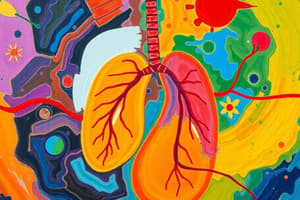Podcast
Questions and Answers
What product of fermentation is a gas at room temperature?
What product of fermentation is a gas at room temperature?
carbon dioxide
What are all the biological processes that are being carried out by a yeast cell that is fermenting sugars to make bread rise?
What are all the biological processes that are being carried out by a yeast cell that is fermenting sugars to make bread rise?
alcoholic fermentation, glycolysis, lactic acid fermentation
Why is it that alcoholic beverages have intoxicating effects, whereas eating bread does not?
Why is it that alcoholic beverages have intoxicating effects, whereas eating bread does not?
Ethanol evaporates out of the bread as it bakes
What is glycolysis?
What is glycolysis?
Describe what happens during glycolysis. How many ATP and NADH molecules are gained during this stage?
Describe what happens during glycolysis. How many ATP and NADH molecules are gained during this stage?
Defend this statement: 'Glycolysis is a universal and ancient pathway for making ATP.'
Defend this statement: 'Glycolysis is a universal and ancient pathway for making ATP.'
Which is the correct formula for cellular respiration?
Which is the correct formula for cellular respiration?
Which is the correct formula for photosynthesis?
Which is the correct formula for photosynthesis?
What is the major difference between photosynthesis and cellular respiration?
What is the major difference between photosynthesis and cellular respiration?
How are photosynthesis and cellular respiration related to each other?
How are photosynthesis and cellular respiration related to each other?
How could an organism live on Earth without using energy that came from the sun at some point?
How could an organism live on Earth without using energy that came from the sun at some point?
What is the last stage in cellular respiration?
What is the last stage in cellular respiration?
What is the role of the Krebs cycle in cellular respiration?
What is the role of the Krebs cycle in cellular respiration?
What is the major ATP generating process in cellular respiration?
What is the major ATP generating process in cellular respiration?
What is the function of glycolysis in cellular respiration?
What is the function of glycolysis in cellular respiration?
When we think of respiration, we usually think of inhaling oxygen and exhaling carbon dioxide. Assuming that all of the CO2 we exhale is waste from cellular respiration, how does the carbon atom in CO2 enter the body?
When we think of respiration, we usually think of inhaling oxygen and exhaling carbon dioxide. Assuming that all of the CO2 we exhale is waste from cellular respiration, how does the carbon atom in CO2 enter the body?
What molecule does the oxygen you inhale become a part of during cellular respiration?
What molecule does the oxygen you inhale become a part of during cellular respiration?
Based on the last two questions, which of these statements is most accurate?
Based on the last two questions, which of these statements is most accurate?
The various processes of cellular respiration take place in the cytoplasm and mitochondria. What compartments do glycolysis, the Krebs cycle, and the electron transport chain occur in?
The various processes of cellular respiration take place in the cytoplasm and mitochondria. What compartments do glycolysis, the Krebs cycle, and the electron transport chain occur in?
What is the main advantage of aerobic respiration? Of anaerobic respiration?
What is the main advantage of aerobic respiration? Of anaerobic respiration?
Name two universal energy-carrying molecules, and explain why most organisms need both carriers rather than just one.
Name two universal energy-carrying molecules, and explain why most organisms need both carriers rather than just one.
Flashcards are hidden until you start studying
Study Notes
Fermentation and its Products
- Carbon dioxide is a gas produced during fermentation.
- Yeast cells ferment sugars through alcoholic fermentation, glycolysis, and lactic acid fermentation.
Alcoholic Fermentation
- Final products include ethanol and carbon dioxide.
- Ethanol is found in alcoholic beverages and evaporates during baking, hence bread does not have intoxicating effects.
Glycolysis Overview
- Glycolysis is the first stage of cellular respiration, occurring in the cytosol, and does not require oxygen.
- Splitting glucose yields two pyruvate molecules and results in a net gain of two ATP molecules.
Glycolysis Significance
- Known as a universal and ancient ATP-making pathway, it functions without organelles.
- Produces two pyruvic acid molecules for every glucose molecule processed.
Cellular Respiration Formulas
- Cellular respiration is represented by the equation: C6H12O6 + 6O2 > 6CO2 + 6H2O + ATP energy.
- Photosynthesis is described by: 6CO2 + 6H2O + light energy > C6H12O6 + 6O2.
Relationship between Photosynthesis and Cellular Respiration
- The two processes are reciprocal in nature; photosynthesis stores energy while cellular respiration releases it.
Life Without Solar Energy
- Organisms can survive using chemosynthesis but ultimately depend on the sun’s energy for raw materials.
Cellular Respiration Stages
- The last stage of cellular respiration is the electron transport chain.
- The Krebs cycle produces reduced cofactors for the electron transport chain, essential for ATP generation.
- Glycolysis functions to produce pyruvate and a small quantity of ATP from glucose.
Carbon Dioxide and Water in Respiration
- Carbon atoms in CO2 enter the body through glucose.
- The oxygen inhaled becomes part of water during cellular respiration.
Miscellaneous Facts
- All cellular respiration processes occur in specific compartments: glycolysis in the cytoplasm, Krebs cycle in the mitochondrial matrix, and electron transport chain in the inner mitochondrial membrane.
- Aerobic respiration is advantageous for producing ATP slowly over time, while anaerobic respiration is quicker, benefiting short bursts of activity.
Energy-Carrying Molecules
- Universal energy carriers include glucose and ATP; ATP is utilized within cells for immediate energy, while glucose serves as a primary energy source.
Studying That Suits You
Use AI to generate personalized quizzes and flashcards to suit your learning preferences.



